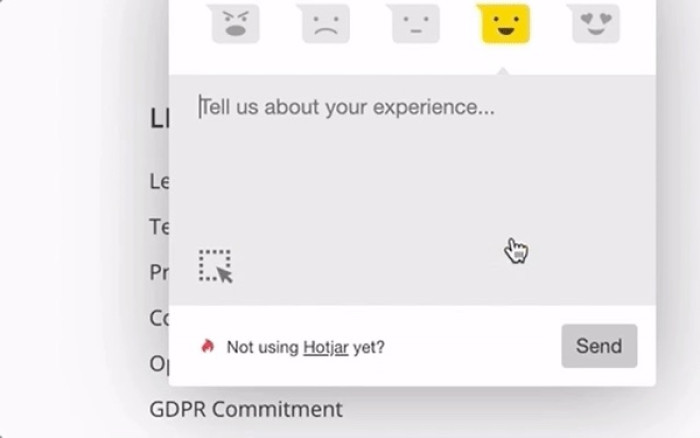“Hey there! Have ~10 minutes to complete this quick online survey?”
We’ve all received some version of this message in our email inboxes. Hardly compelling, is it?
Unless users love the product or feel prompted to give feedback for their own reasons, they're unlikely to even open an email survey, forget dedicating 10 minutes to it.
Why are product surveys so demanding?
Product managers are often told how important it is to talk and listen to customers. There’s truth in this, and user surveys are a great way to get feedback. But how can you be sure your surveys aren’t dead in the water?
This article takes a look at microsurveys, with the intent to shed some light on survey design and delivery techniques you can leverage to compel users to respond.
What is a Microsurvey?
A microsurvey is a type of user survey with the following characteristics:
One question, with space for comments and feedback;
Context-specific (triggered by specific user actions);
Bonus: Delivered in-product.
Net Promoter Score (NPS) surveys have become so popular in recent years for a reason; they’re short and simple, consisting of a single rating prompt followed by optional text comments.
Let’s look at an example:


In the above example, Hotjar makes the intent and required effort obvious. It’s also delivered in-app, so the user is still in flow and their cognitive load is persuasively low. This subtle consideration alleviates friction from the user—and is the perfect way to gather highly specific feedback about your product.
By respecting a user’s time and energy, you make them feel valued, appreciated, and inclined to help.
Users don’t owe you survey responses - you have to earn them!
We’ve applied this philosophy to enable product teams to create and deploy in-product microsurveys with Chameleon, which supports multiple types of popular microsurveys and the ability to build custom feedback prompts from scratch.
The problem with traditional surveys
"Traditional” surveys - delivered via email or in-app prompts without context - suffer because they make it difficult for teams to collect meaningful data. Why?
Users are not necessarily thinking critically about your product when they’re checking their email;
Without context-specific triggers, they are typically more general, meaning you’re either asking a lot from your users (longer surveys) or you’re collecting less useful information (vague questions);
Typically longer, which is an instant turn-off.
Why Microsurveys do it better
The main benefits of using in-app Microsurveys include:
Highly useful and contextual responses
Users are more likely to respond
Enables a continuous feedback loop between the user and product
Fast responses - a shorter gap between deploying and seeing significant results
Customer research has shown that response rates for in-product surveys are about double that of email, with Chameleon customers like Mixpanel and SkySlope reporting a marked increase in the speed of feedback collection.
In-product microsurveys are more appealing to users because they’re less effort. When users actually want to express some kind of feedback (be it satisfaction or dissatisfaction) but it’s not immediately clear how they can do that, they will be frustrated (and eventually, you will feel their wrath).
They also allow you to better understand a user’s motivations, meaning the data you gather is supremely more useful. Microsurveys with Chameleon are tied to a set of in-app actions that give context to each response. Knowing what the user was doing immediately before they gave feedback shines a light on their motivations and helps you make better product design decisions.
This also means users will only be asked a question about a product feature if they actually used it.
Microsurveys can be set up to be completely automated, allowing you to passively collect highly actionable, feature-specific feedback.
Not convinced? We’d be happy to set you up with a demo and discuss which microsurveys would be a good fit for your product.

Get the Right Features on Your Product Roadmap
Discover how to gather specific feedback that guides your roadmap with microsurveys—check out our on-demand webinar.
Key principles of compelling survey design
When product teams are tasked with crafting effective user surveys, the following key principles should be the most important considerations:
Context
Target audience
Design
Tracking and analytics
Context
When using traditional survey tools like Google Forms, Typeform, or SurveyMonkey—whether standalone or integrated into product management or project management tools—product teams tend to fall into the trap of building surveys that are long-form and broad in scope, covering a range of different aspects of the product.
Traditional survey tools such as these are limited in how and when they can deliver their surveys (pretty much a one-size-fits-all email and a prayer to the product gods that the user in question will actually know what feature the survey is talking about). In short, they’re delivered without proper context.
Of course, you can always talk to your customers and you could break these questions down into smaller, more digestible (and more focused) surveys. But doing this without proper context only further reduces the probability that users will have used the product features you’re talking about.
With microsurveys, context is baked into delivery. When building any kind of in-product user survey, you need to consider the user’s journey. What were they doing immediately before the feedback, and what action should actually trigger the microsurvey to appear for them?
Asking questions too early or too late has the same result - poor survey responses due to a lack of proper context. You need to find the sweet spot between users experiencing a feature for the first time and the point where they have enough relevant experience to provide meaningful feedback. Decide what action should be the trigger and start implementing microsurveys.
Target audience
Understanding and segmenting your users allows you to align value proposition with the target market, and this insight underpins almost all survey design decisions. Crucially, the question to ask here is this:
How do specific product features help users achieve their goals?
This kind of questioning encourages you to build surveys that focus on gathering feedback about how to enable product success, and help your product development team improve existing and implement new features.
If a subset of users is the main audience for the feature you're asking for feedback on, then survey that subset.
Design
Being able to customize the design and styling of surveys (especially in-product surveys) ensures a streamlined user experience that doesn’t interfere with user expectations or brand image. Down to the very last pixel, you can choose exactly where and how you would like your microsurvey to appear in front of each user. You can use your own brand colors and fonts to create pop-ups that offer a truly native experience.
Tracking and analytics
Looking at the data on how your microsurveys are performing will quickly allow you to identify the most and least engaging questions. If certain questions are consistently getting fewer responses than others, then you should consider how to reframe them to make them more compelling to answer.

Use Chameleon and Heap to deeply analyze your Microsurveys
Learn how to use the best combination of in-product Experiences and analytics to track survey results and help reduce churn.
How Microsurveys facilitate continuous feedback
Users in this day and age want instant service as well as the convenience of being serviced when it suits them best. A product-led growth approach will help you align with the needs of your users.
Usage analytics and A/B testing are valuable sources of truth for understanding users, and they will help you develop your product-market fit by exploring how functionality meets market expectations. But with this approach, you will often encounter the problem of how to build and launch new features that your users are compelled to use.
This isn’t necessarily because you’re moving too slow or running too few A/B tests, but rather more likely it’s because you’re not aligning customer feedback management with your product development process.
By offering continuous in-product user feedback as a base standard in all of your products, you will be at a significant advantage in developing and launching exciting new products and features.
Microsurveys = more compelling user surveys
Chameleon makes it easy for your team to effortlessly deploy in-product microsurveys via the many premade templates (or building your own with a responsive and intuitive no-code editor).
Here’s a selection of some of the pre-made survey types available in Chameleon:

At Chameleon, our goal is to help you implement in-product user surveys as easily and painlessly as possible. That’s why we offer a range of tools and customization options, without the need for any coding or developer experience.
In summary, the key takeaways here are as follows:
Microsurveys will help you deliver more compelling user surveys due to better context around how and when they’re delivered, as well as being shorter and focused on a single aspect or feature.
Always design your surveys with different user profiles and segmentation in mind. This will help improve response rates and gather more relevant, actionable insights.
Understand the different types of user surveys! There are many different approaches and qualitative forms of feedback you can gather to help drive product-led growth and improve product design.
We believe that microsurveys are the future of user research, and we’ve written extensively on the value of user surveys and continuous feedback. Check out some of our other articles here:
Ultimate Guide to Intelligent Product Surveys (with 12 Examples)
In-App Survey Design: Best Practice Principles for Product Teams
How to Generate Killer Product Growth with Experimentation (5 Step Process)
How to Build a High-Touch SaaS Product Onboarding Experience
Take a deeper dive into microsurveys in our expert session webinar. Check the short summary and get the recording below:

On-Demand Webinar: How to Use Microsurveys
Equip your team with a modern approach to user feedback that powers product development ⚡




